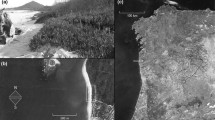Abstract
Field farming of Gracilaria chilensis in Chile is mainly based on the regenerative capacity of thallus fragments. This study evaluates experimentally the effects on growth of the few organismic determinants that the farmer is capable of effectively handling in the field. No differences were found in the length increments of ramets with and without apices, a surprising result in view of the generally accepted idea that the most important growth meristem in this group of algae is located in the apex of the thallus. Total elongation and increase in weight of fragments with an initial length of up to 20 cm are a function of the initial length of the ramet, suggesting that intercalary growth makes a significant contribution to growth. Vegetative female axes grow faster, (in terms of length and weight) and produce more laterals than fertile female axes, and these faster than fertile tetrasporic branches. No differences in the growth of ramets originating from proximal or distal parts of axes were found.
Similar content being viewed by others
References
Brinkhuis BH (1985) Growth patterns and rates. In Littler MM, Littler DS (eds), Handbook of Physiological Methods. Ecological Field Methods: Macroalgae. Cambridge University Press, Cambridge: 462–477.
Buschmann A, Westermeier R, Retamales C (1995) Cultivation of Gracilaria on the sea-bottom in southern Chile: a review. J. appl. Phycol. 7: 291–301.
De Wreede R, Klinger T (1988). Reproductive strategies in algae. In Lovett-Doust J, Lovett-Doust L (eds), Plant Reproductive Ecology: Patterns and Strategies. Oxford University Press, Oxford: 267–284.
Edelstein T (1977) Studies on Gracilaria sp.: experiments on inocula incubated under greenhouse conditions. J. exp. mar. Biol. Ecol. 30: 249–259.
Hanisak MD (1987) Cultivation of Gracilaria and other macroalgae in Florida for energy production. In Bird KT, Benson PH Bensoni (eds), Seaweed Cultivation for Renewable Resources. Elsevier, New York: 191–218.
Hoyle MO (1975) Marine Agronomy U.S. Sea Grant Program. University of Hawaii, U.S.A., 340 pp.
Kim DH, Henriquez NP (1979) Yields and gel strengths of agar from cystocarpic and tetrasporic plants of Gracilaria verrucosa (Florideophyceae). Proc. Int. Seaweed Symp. 9: 257–262.
Mathieson AC, Guo Z (1992) Patterns of fucoid reproductive biomass allocation. Br. phycol. J. 27: 271–292.
McLachlan J, Bird CJ (1986) Gracilaria (Gigartinales, Rhodophyta) and productivity. Aquat. Bot. 26 (1–2): 27–49.
Pizarro A, Santelices B (1993) Environmental variation and large-scale Gracilaria production. Hydrobiologia 260/261 (Dev. Hydrobiol. 85): 357–363.
Ren G-Z, Chen M-Q (1986) The effect of temperature on the growth and development of Gracilaria asiatica. Oceanol. Limnol. Sin. 17: 283–293 (in Chinese with English Abstract).
Santelices B (1990) Patterns of reproduction, dispersal and recruitment in seaweeds. Oceanogr. Mar. Biol. Annu. Rev. 28: 177–276.
Santelices B, Doty MS (1989) A review of Gracilaria farming. Aquaculture 78: 95–133.
Sokal RS, Rohlf FJ (1969) Biometry. WH Freeman & Co., San Francisco, 776 pp.
Westermeier R, Rivera PJ, Gómez I (1991) Cultivo de Gracilaria chilensis Bird, McLachlan y Oliveira, en la zona intermareal y submareal del Estuario Carquilda, Maullin, Chile. Rev. ch. Hist. nat. 64: 307–322.
Author information
Authors and Affiliations
Additional information
Paper presented at the XVth International Seaweed Symposium.
Rights and permissions
About this article
Cite this article
Santelices, B., Varela, D. Regenerative capacity of Gracilaria fragments: effects of size, reproductive state and position along the axis. J Appl Phycol 7, 501–506 (1995). https://doi.org/10.1007/BF00003935
Received:
Revised:
Accepted:
Issue Date:
DOI: https://doi.org/10.1007/BF00003935




